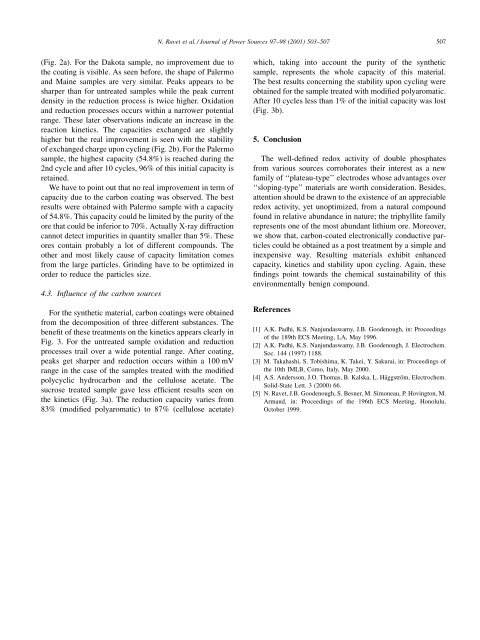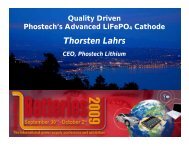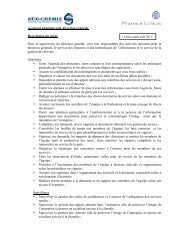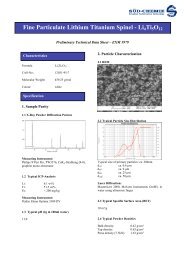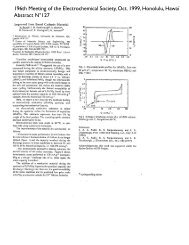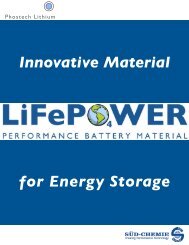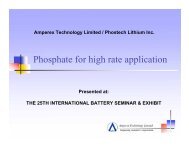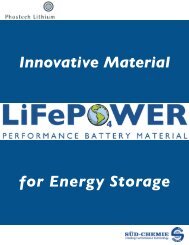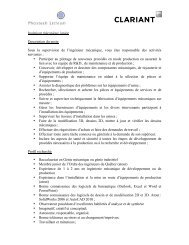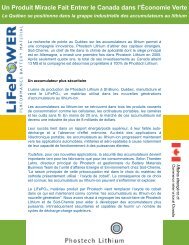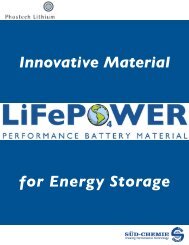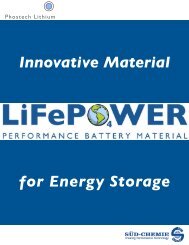Electroactivity of natural and synthetic triphylite - Phostech Lithium inc.
Electroactivity of natural and synthetic triphylite - Phostech Lithium inc.
Electroactivity of natural and synthetic triphylite - Phostech Lithium inc.
- No tags were found...
You also want an ePaper? Increase the reach of your titles
YUMPU automatically turns print PDFs into web optimized ePapers that Google loves.
N. Ravet et al. / Journal <strong>of</strong> Power Sources 97±98 2001) 503±507 507<br />
Fig. 2a). For the Dakota sample, no improvement due to<br />
the coating is visible. As seen before, the shape <strong>of</strong> Palermo<br />
<strong>and</strong> Maine samples are very similar. Peaks appears to be<br />
sharper than for untreated samples while the peak current<br />
density in the reduction process is twice higher. Oxidation<br />
<strong>and</strong> reduction processes occurs within a narrower potential<br />
range. These later observations indicate an <strong>inc</strong>rease in the<br />
reaction kinetics. The capacities exchanged are slightly<br />
higher but the real improvement is seen with the stability<br />
<strong>of</strong> exchanged charge upon cycling Fig. 2b). For the Palermo<br />
sample, the highest capacity 54.8%) is reached during the<br />
2nd cycle <strong>and</strong> after 10 cycles, 96% <strong>of</strong> this initial capacity is<br />
retained.<br />
We have to point out that no real improvement in term <strong>of</strong><br />
capacity due to the carbon coating was observed. The best<br />
results were obtained with Palermo sample with a capacity<br />
<strong>of</strong> 54.8%. This capacity could be limited by the purity <strong>of</strong> the<br />
ore that could be inferior to 70%. Actually X-ray diffraction<br />
cannot detect impurities in quantity smaller than 5%. These<br />
ores contain probably a lot <strong>of</strong> different compounds. The<br />
other <strong>and</strong> most likely cause <strong>of</strong> capacity limitation comes<br />
from the large particles. Grinding have to be optimized in<br />
order to reduce the particles size.<br />
4.3. Influence <strong>of</strong> the carbon sources<br />
For the <strong>synthetic</strong> material, carbon coatings were obtained<br />
from the decomposition <strong>of</strong> three different substances. The<br />
bene®t <strong>of</strong> these treatments on the kinetics appears clearly in<br />
Fig. 3. For the untreated sample oxidation <strong>and</strong> reduction<br />
processes trail over a wide potential range. After coating,<br />
peaks get sharper <strong>and</strong> reduction occurs within a 100 mV<br />
range in the case <strong>of</strong> the samples treated with the modi®ed<br />
polycyclic hydrocarbon <strong>and</strong> the cellulose acetate. The<br />
sucrose treated sample gave less ef®cient results seen on<br />
the kinetics Fig. 3a). The reduction capacity varies from<br />
83% modi®ed polyaromatic) to 87% cellulose acetate)<br />
which, taking into account the purity <strong>of</strong> the <strong>synthetic</strong><br />
sample, represents the whole capacity <strong>of</strong> this material.<br />
The best results concerning the stability upon cycling were<br />
obtained for the sample treated with modi®ed polyaromatic.<br />
After 10 cycles less than 1% <strong>of</strong> the initial capacity was lost<br />
Fig. 3b).<br />
5. Conclusion<br />
The well-de®ned redox activity <strong>of</strong> double phosphates<br />
from various sources corroborates their interest as a new<br />
family <strong>of</strong> ``plateau-type'' electrodes whose advantages over<br />
``sloping-type'' materials are worth consideration. Besides,<br />
attention should be drawn to the existence <strong>of</strong> an appreciable<br />
redox activity, yet unoptimized, from a <strong>natural</strong> compound<br />
found in relative abundance in nature; the triphyllite family<br />
represents one <strong>of</strong> the most abundant lithium ore. Moreover,<br />
we show that, carbon-coated electronically conductive particles<br />
could be obtained as a post treatment by a simple <strong>and</strong><br />
inexpensive way. Resulting materials exhibit enhanced<br />
capacity, kinetics <strong>and</strong> stability upon cycling. Again, these<br />
®ndings point towards the chemical sustainability <strong>of</strong> this<br />
environmentally benign compound.<br />
References<br />
[1] A.K. Padhi, K.S. Nanjundaswamy, J.B. Goodenough, in: Proceedings<br />
<strong>of</strong> the 189th ECS Meeting, LA, May 1996.<br />
[2] A.K. Padhi, K.S. Nanjundaswamy, J.B. Goodenough, J. Electrochem.<br />
Soc. 144 1997) 1188.<br />
[3] M. Takahashi, S. Tobishima, K. Takei, Y. Sakurai, in: Proceedings <strong>of</strong><br />
the 10th IMLB, Como, Italy, May 2000.<br />
[4] A.S. Andersson, J.O. Thomas, B. Kalska, L. HaÈggstroÈm, Electrochem.<br />
Solid-State Lett. 3 2000) 66.<br />
[5] N. Ravet, J.B. Goodenough, S. Besner, M. Simoneau, P. Hovington, M.<br />
Arm<strong>and</strong>, in: Proceedings <strong>of</strong> the 196th ECS Meeting, Honolulu,<br />
October 1999.


